

Compact Muon Solenoid
LHC, CERN
| CMS-SMP-18-015 ; CERN-EP-2019-167 | ||
| Evidence for WW production from double-parton interactions in proton-proton collisions at $\sqrt{s} = $ 13 TeV | ||
| CMS Collaboration | ||
| 13 September 2019 | ||
| Eur. Phys. J. C 80 (2020) 41 | ||
| Abstract: A search for WW production from double-parton scattering processes using same-charge electron-muon and dimuon events is reported, based on proton-proton collision data collected at a center-of-mass energy of 13 TeV. The analyzed data set corresponds to an integrated luminosity of 77.4 fb$^{-1}$, collected using the CMS detector at the LHC in 2016 and 2017. Multivariate classifiers are used to discriminate between the signal and the dominant background processes. A maximum likelihood fit is performed to extract the signal cross section. This leads to the first evidence for WW production via double-parton scattering, with a significance of 3.9 standard deviations. The measured inclusive cross section is 1.41 $\pm$ 0.28 (stat) $\pm$ 0.28 (syst) pb. | ||
| Links: e-print arXiv:1909.06265 [hep-ex] (PDF) ; CDS record ; inSPIRE record ; HepData record ; CADI line (restricted) ; | ||
| Figures | |

png pdf |
Figure 1:
Schematic diagrams corresponding to the production of $\mathrm{W} ^{\pm}\mathrm{W} ^{\pm}$ via the DPS process (left) and via SHS processes (middle and right), with both W bosons further decaying leptonically. |
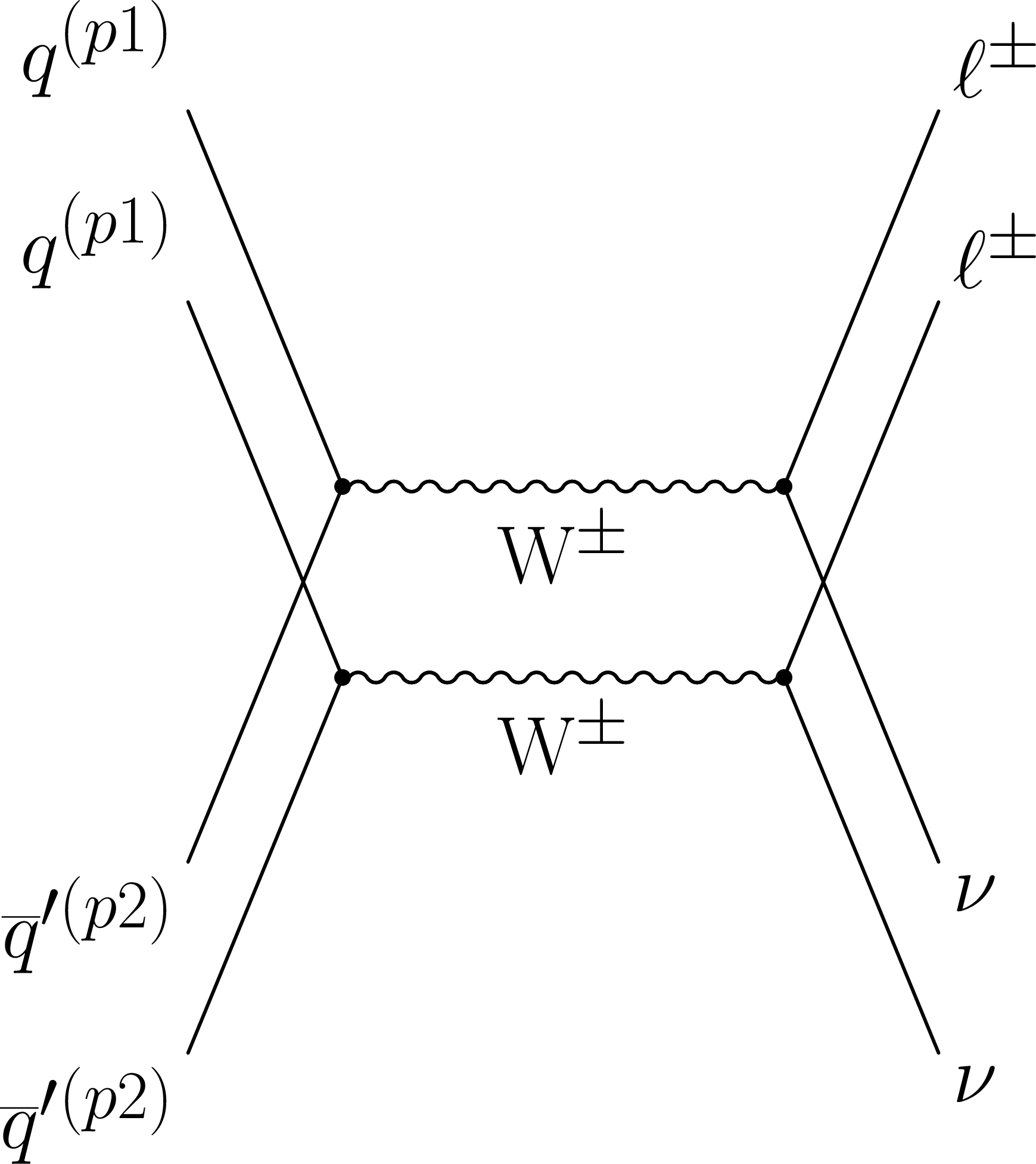
png pdf |
Figure 1-a:
Schematic diagram corresponding to the production of $\mathrm{W} ^{\pm}\mathrm{W} ^{\pm}$ via the DPS process, with both W bosons further decaying leptonically. |
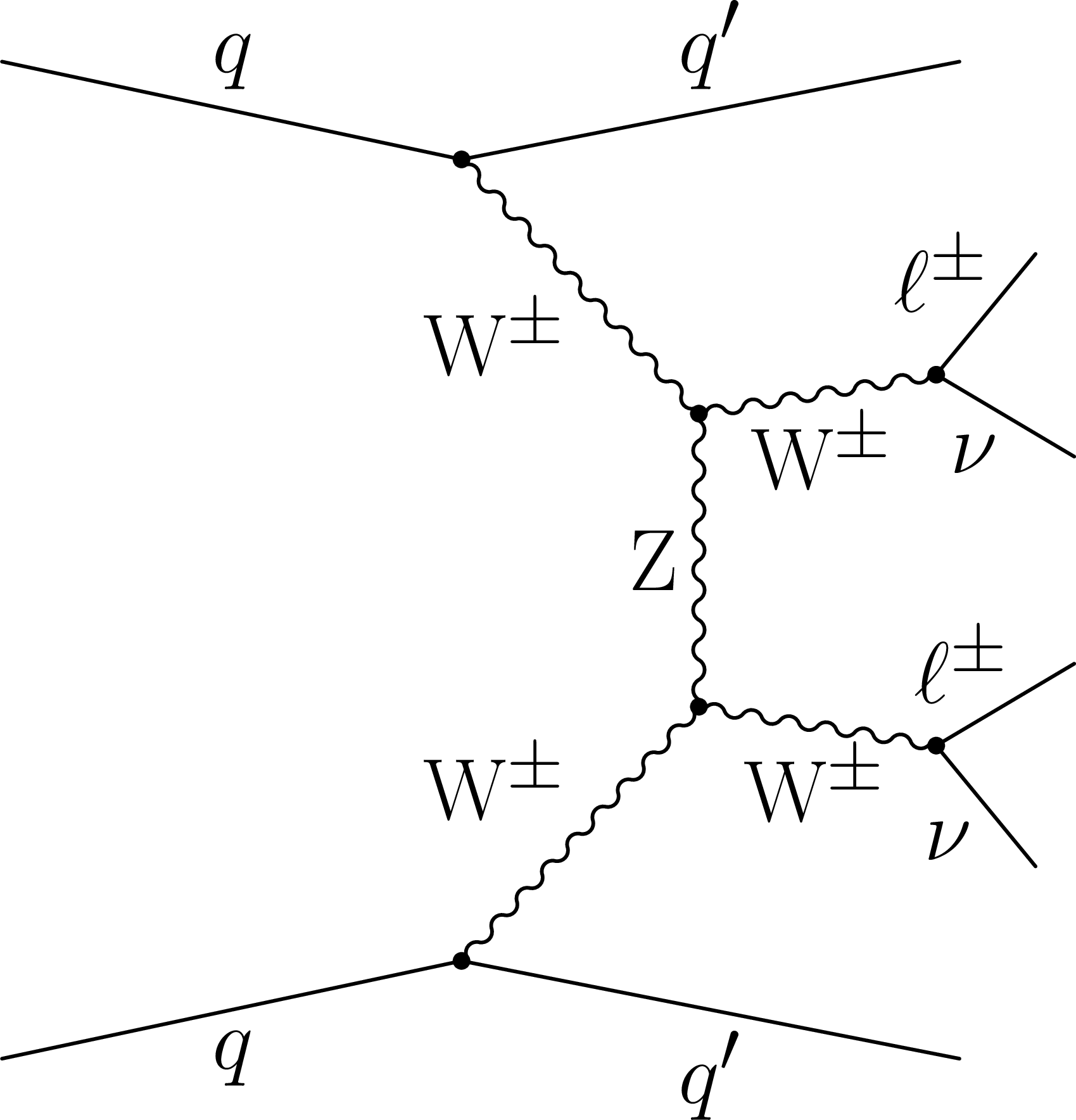
png pdf |
Figure 1-b:
Schematic diagram corresponding to the production of $\mathrm{W} ^{\pm}\mathrm{W} ^{\pm}$ via a SHS process, with both W bosons further decaying leptonically. |
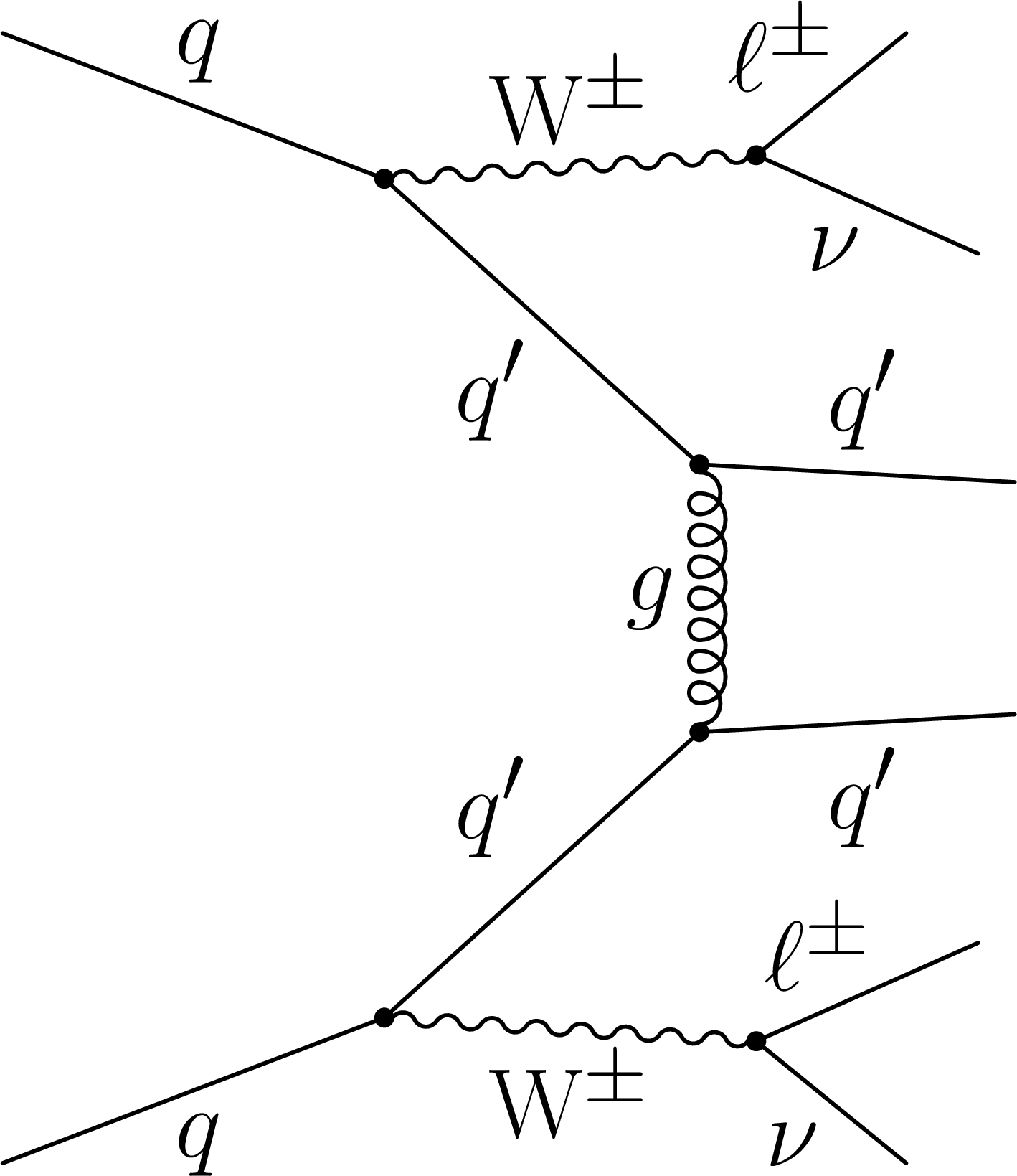
png pdf |
Figure 1-c:
Schematic diagram corresponding to the production of $\mathrm{W} ^{\pm}\mathrm{W} ^{\pm}$ via a SHS process, with both W bosons further decaying leptonically. |
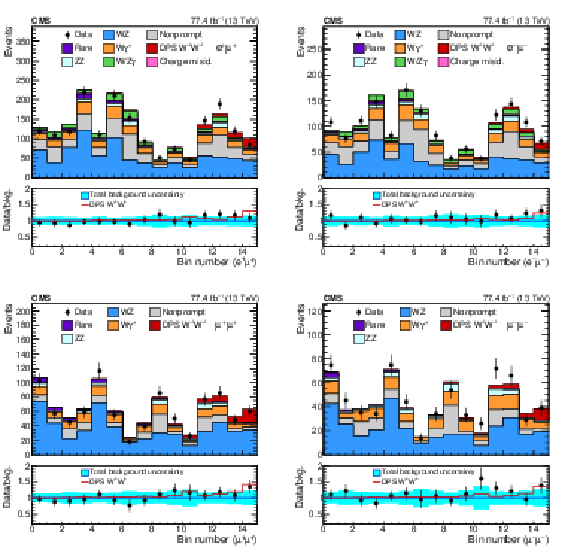
png pdf |
Figure 2:
Distribution of the final BDT classifier output for e$\mu$ (upper) and $\mu\mu$ (lower) final states, in the positive (left) and negative (right) charge configurations. Observed data are shown in black markers while the backgrounds and signal are shown in colored histograms with their postfit yields. The SHS $\mathrm{W} ^{\pm}\mathrm{W} ^{\pm}$ and WWW contributions are grouped in the "Rare'' background category. The bottom panels show the ratio of data to the sum of all background contributions in the black markers along with the signal shown using a red line. The band represents the postfit background uncertainty, which includes both the statistical and systematic components. |

png pdf |
Figure 2-a:
Distribution of the final BDT classifier output for the e$\mu$ final state, in the positive charge configuration. Observed data are shown in black markers while the backgrounds and signal are shown in colored histograms with their postfit yields. The SHS $\mathrm{W} ^{\pm}\mathrm{W} ^{\pm}$ and WWW contributions are grouped in the "Rare'' background category. The bottom panel shows the ratio of data to the sum of all background contributions in the black markers along with the signal shown using a red line. The band represents the postfit background uncertainty, which includes both the statistical and systematic components. |
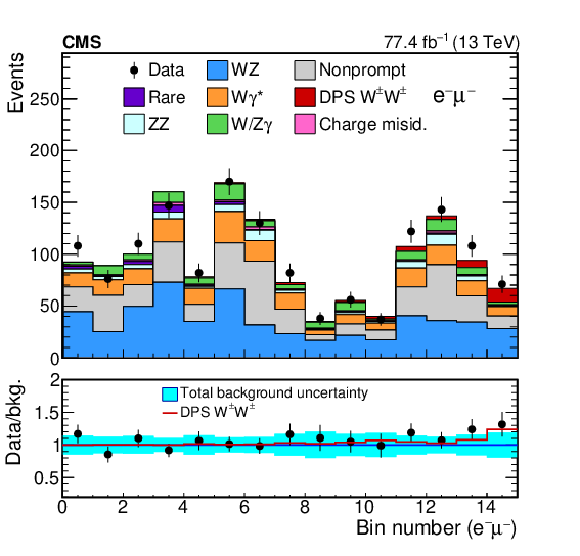
png pdf |
Figure 2-b:
Distribution of the final BDT classifier output for the e$\mu$ final state, in the negative charge configuration. Observed data are shown in black markers while the backgrounds and signal are shown in colored histograms with their postfit yields. The SHS $\mathrm{W} ^{\pm}\mathrm{W} ^{\pm}$ and WWW contributions are grouped in the "Rare'' background category. The bottom panel shows the ratio of data to the sum of all background contributions in the black markers along with the signal shown using a red line. The band represents the postfit background uncertainty, which includes both the statistical and systematic components. |

png pdf |
Figure 2-c:
Distribution of the final BDT classifier output for the $\mu\mu$ final state, in the positive charge configuration. Observed data are shown in black markers while the backgrounds and signal are shown in colored histograms with their postfit yields. The SHS $\mathrm{W} ^{\pm}\mathrm{W} ^{\pm}$ and WWW contributions are grouped in the "Rare'' background category. The bottom panel shows the ratio of data to the sum of all background contributions in the black markers along with the signal shown using a red line. The band represents the postfit background uncertainty, which includes both the statistical and systematic components. |
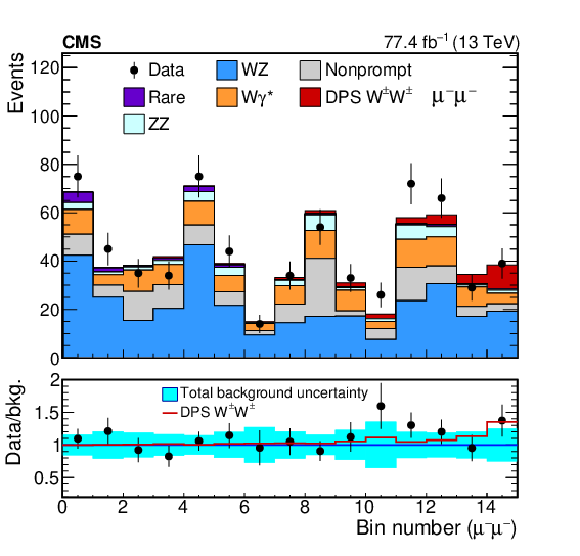
png pdf |
Figure 2-d:
Distribution of the final BDT classifier output for the $\mu\mu$ final state, in the negative charge configuration. Observed data are shown in black markers while the backgrounds and signal are shown in colored histograms with their postfit yields. The SHS $\mathrm{W} ^{\pm}\mathrm{W} ^{\pm}$ and WWW contributions are grouped in the "Rare'' background category. The bottom panel shows the ratio of data to the sum of all background contributions in the black markers along with the signal shown using a red line. The band represents the postfit background uncertainty, which includes both the statistical and systematic components. |
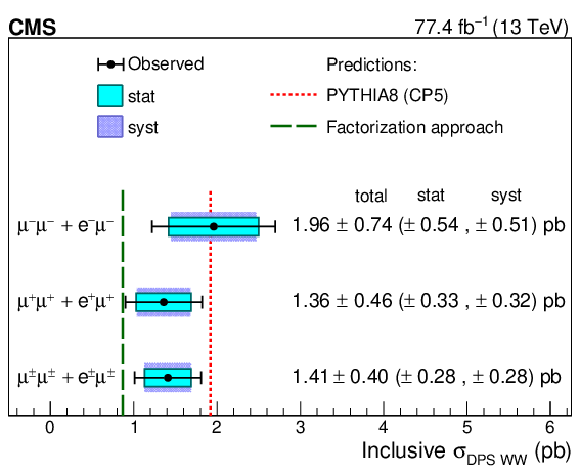
png pdf |
Figure 3:
Observed cross section values for inclusive DPS WW production from the two lepton charge configurations and their combination. These values are obtained from the extrapolation of the observed DPS $\mathrm{W} ^{\pm}\mathrm{W} ^{\pm}$ cross section to the inclusive WW case. The statistical and systematic uncertainties are shown using shaded bands. The predictions from PYTHIA and from the factorization approach are represented with the red dotted and green dashed lines, respectively. |
| Tables | |
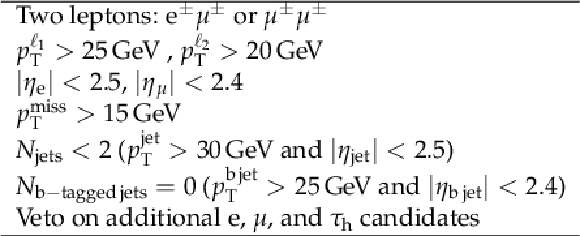
png pdf |
Table 1:
Event selection criteria. |

png pdf |
Table 2:
Postfit background and signal yields and their uncertainties, and the observed event counts in the four charge and flavor combinations. The uncertainties include both statistical and systematic components. The SHS $\mathrm{W} ^{\pm}\mathrm{W} ^{\pm}$ and WWW contributions are grouped as the "Rare'' background. |

png pdf |
Table 3:
Results obtained from the maximum likelihood fit to the final classifier distribution. |
| Summary |
| A study of WW production from double-parton scattering (DPS) processes in proton-proton collisions at $\sqrt{s} = $ 13 TeV has been reported. The analyzed data set corresponds to an integrated luminosity of 77.4 fb$^{-1}$, collected using the CMS detector in 2016 and 2017 at the LHC. The WW candidates are selected in same-charge electron-muon or dimuon events with moderate missing transverse momentum and low jet multiplicity. Multivariate classifiers based on boosted decision trees are used to discriminate between the signal and the dominant background processes. A maximum likelihood fit is performed to extract the signal cross section, which is compared to the predictions from simulation and from an approximate factorization approach. A measurement of the DPS WW cross section is achieved for the first time, and a cross section of 1.41 $\pm$ 0.28 (stat) $\pm$ 0.28 (syst) pb is extracted with an observed significance of 3.9 standard deviations. This cross section leads to an effective cross section parameter of $\sigma_{\text{eff}}=$ 12.7$^{+ 5.0}_{- 2.9}$ mb. This result is the first evidence for DPS WW production. |
| References | ||||
| 1 | C. Goebel, F. Halzen, and D. M. Scott | Double Drell-Yan annihilations in hadron collisions: novel tests of the constituent picture | PRD 22 (1980) 2789 | |
| 2 | V. P. Shelest, A. M. Snigirev, and G. M. Zinovev | The multiparton distribution equations in QCD | PLB 113 (1982) 325 | |
| 3 | T. Sjostrand and M. van Zijl | A multiple interaction model for the event structure in hadron collisions | PRD 36 (1987) 2019 | |
| 4 | G. Calucci and D. Treleani | Disentangling correlations in multiple parton interactions | PRD 83 (2011) 016012 | 1009.5881 |
| 5 | M. Diehl, D. Ostermeier, and A. Schafer | Elements of a theory for multiparton interactions in QCD | JHEP 03 (2012) 089 | 1111.0910 |
| 6 | B. Blok, \relax Yu. Dokshitzer, L. Frankfurt, and M. Strikman | Perturbative QCD correlations in multi-parton collisions | EPJC 74 (2014) 2926 | 1306.3763 |
| 7 | M. Diehl and J. R. Gaunt | Double parton scattering theory overview | Adv. Ser. Direct. High Energy Phys. 29 (2018) 7 | 1710.04408 |
| 8 | AFS Collaboration | Double parton scattering in pp collisions at $ \sqrt{s}= $ 63 GeV | Z. Phys. C 34 (1987) 163 | |
| 9 | UA2 Collaboration | A study of multi-jet events at the CERN $ \overline{\rm p} $p collider and a search for double parton scattering | PLB 268 (1991) | |
| 10 | CDF Collaboration | Study of four-jet events and evidence for double parton interactions in p$ \overline{\rm p} $ collisions at $ \sqrt{s} = $ 1.8 TeV | PRD 47 (1993) 4857 | |
| 11 | CDF Collaboration | Double parton scattering in $ \overline{\mathrm{p}} $p collisions at $ \sqrt{s} = $ 1.8 TeV | PRD 56 (1997) 3811 | |
| 12 | CDF Collaboration | Measurement of double parton scattering in $ \overline{\mathrm{p}} $p collisions at $ \sqrt{s} = $ 1.8 TeV | PRL 79 (1997) 584 | |
| 13 | D0 Collaboration | Double parton interactions in $ {\gamma}+3 $ jet events in p$ \overline{\rm p} $ collisions at $ \sqrt{s}= $ 1.96 TeV | PRD 81 (2010) 052012 | 0912.5104 |
| 14 | LHCb Collaboration | Observation of double charm production involving open charm in pp collisions at $ \sqrt{s} = $ 7 TeV | JHEP 06 (2012) 141 | 1205.0975 |
| 15 | ATLAS Collaboration | Measurement of hard double-parton interactions in W$ (\to {l\nu}) $+ 2 jet events at $ \sqrt{s} = $ 7 TeV with the ATLAS detector | New J. Phys. 15 (2013) 033038 | 1301.6872 |
| 16 | CMS Collaboration | Study of double parton scattering using W + 2-jet events in proton-proton collisions at $ \sqrt{s} = $ 7 TeV | JHEP 03 (2014) 032 | CMS-FSQ-12-028 1312.5729 |
| 17 | CMS Collaboration | Constraints on the double-parton scattering cross section from same-sign W boson pair production in proton-proton collisions at $ \sqrt{s}= $ 8 TeV | JHEP 02 (2018) 032 | CMS-FSQ-16-005 1712.02280 |
| 18 | ATLAS Collaboration | Study of the hard double-parton scattering contribution to inclusive four-lepton production in pp collisions at $ \sqrt s= $ 8 TeV with the ATLAS detector | PLB 790 (2019) 595 | 1811.11094 |
| 19 | CMS Collaboration | Event generator tunes obtained from underlying event and multiparton scattering measurements | EPJC 76 (2016) 155 | CMS-GEN-14-001 1512.00815 |
| 20 | A. Kulesza and W. J. Stirling | Like sign W boson production at the LHC as a probe of double parton scattering | PLB 475 (2000) 168 | hep-ph/9912232 |
| 21 | J. R. Gaunt, C.-H. Kom, A. Kulesza, and W. J. Stirling | Same-sign W pair production as a probe of double parton scattering at the LHC | EPJC 69 (2010) 53 | 1003.3953 |
| 22 | F. A. Ceccopieri, M. Rinaldi, and S. Scopetta | Parton correlations in same-sign W pair production via double parton scattering at the LHC | PRD 95 (2017) 114030 | 1702.05363 |
| 23 | CMS Collaboration | Searches for electroweak production of charginos, neutralinos, and sleptons decaying to leptons and W, Z, and Higgs bosons in pp collisions at 8 TeV | EPJC 74 (2014) 3036 | CMS-SUS-13-006 1405.7570 |
| 24 | CMS Collaboration | The CMS trigger system | JINST 12 (2017) P01020 | CMS-TRG-12-001 1609.02366 |
| 25 | CMS Collaboration | The CMS experiment at the CERN LHC | JINST 3 (2008) S08004 | CMS-00-001 |
| 26 | CMS Collaboration | Particle-flow reconstruction and global event description with the CMS detector | JINST 12 (2017) P10003 | CMS-PRF-14-001 1706.04965 |
| 27 | CMS Collaboration | Performance of electron reconstruction and selection with the CMS detector in proton-proton collisions at $ \sqrt{s} = $ 8 TeV | JINST 10 (2015) P06005 | CMS-EGM-13-001 1502.02701 |
| 28 | CMS Collaboration | Performance of the CMS muon detector and muon reconstruction with proton-proton collisions at $ \sqrt{s}= $ 13 TeV | JINST 13 (2018) P06015 | CMS-MUO-16-001 1804.04528 |
| 29 | CMS Collaboration | Performance of missing transverse momentum in pp collisions at $ \sqrt{s} = $ 13 TeV using the CMS detector | CMS-PAS-JME-17-001 | CMS-PAS-JME-17-001 |
| 30 | CMS Collaboration | Performance of reconstruction and identification of $ \tau $ leptons decaying to hadrons and $ \nu_{\tau} $ in pp collisions at $ \sqrt{s}= $ 13 TeV | JINST 13 (2018) P10005 | CMS-TAU-16-003 1809.02816 |
| 31 | M. Cacciari, G. P. Salam, and G. Soyez | The anti-$ {k_{\mathrm{T}}} $ jet clustering algorithm | JHEP 04 (2008) 063 | 0802.1189 |
| 32 | M. Cacciari, G. P. Salam, and G. Soyez | FastJet user manual | EPJC 72 (2012) 1896 | 1111.6097 |
| 33 | M. Cacciari and G. P. Salam | Dispelling the N$ ^3 $ myth for the $ k_{\rm T} $ jet-finder | PLB 641 (2006) 57 | hep-ph/0512210 |
| 34 | CMS Collaboration | Identification of b quark jets with the CMS experiment | JINST 8 (2013) P04013 | CMS-BTV-12-001 1211.4462 |
| 35 | CMS Collaboration | Identification of heavy-flavour jets with the CMS detector in pp collisions at 13 TeV | JINST 13 (2018) P05011 | CMS-BTV-16-002 1712.07158 |
| 36 | CMS Collaboration | Jet energy scale and resolution in the CMS experiment in pp collisions at 8 TeV | JINST 12 (2017) P02014 | CMS-JME-13-004 1607.03663 |
| 37 | CMS Collaboration | Evidence for associated production of a Higgs boson with a top quark pair in final states with electrons, muons, and hadronically decaying $ \tau $ leptons at $ \sqrt{s} = $ 13 TeV | JHEP 08 (2018) 066 | CMS-HIG-17-018 1803.05485 |
| 38 | H. Voss, A. Hocker, J. Stelzer, and F. Tegenfeldt | TMVA, the toolkit for multivariate data analysis with ROOT | in XIth International Workshop on Advanced Computing and Analysis Techniques in Physics Research (ACAT), p. 40 2007 | physics/0703039 |
| 39 | T. Sjostrand et al. | An introduction to PYTHIA 8.2 | CPC 191 (2015) 159 | 1410.3012 |
| 40 | CMS Collaboration | Extraction and validation of a new set of CMS PYTHIA8 tunes from underlying-event measurements | Submitted to EPJC | CMS-GEN-17-001 1903.12179 |
| 41 | M. Bahr et al. | Herwig++ physics and manual | EPJC 58 (2008) 639 | 0803.0883 |
| 42 | J. Pumplin et al. | New generation of parton distributions with uncertainties from global QCD analysis | JHEP 07 (2002) 012 | hep-ph/0201195 |
| 43 | S. Frixione, P. Nason, and C. Oleari | Matching NLO QCD computations with parton shower simulations: the POWHEG method | JHEP 11 (2007) 070 | 0709.2092 |
| 44 | S. Alioli, P. Nason, C. Oleari, and E. Re | A general framework for implementing NLO calculations in shower Monte Carlo programs: the POWHEG BOX | JHEP 06 (2010) 043 | 1002.2581 |
| 45 | J. Alwall et al. | The automated computation of tree-level and next-to-leading order differential cross sections, and their matching to parton shower simulations | JHEP 07 (2014) 079 | 1405.0301 |
| 46 | R. Frederix and S. Frixione | Merging meets matching in MC@NLO | JHEP 12 (2012) 061 | 1209.6215 |
| 47 | J. Alwall et al. | Comparative study of various algorithms for the merging of parton showers and matrix elements in hadronic collisions | EPJC 53 (2008) 473 | 0706.2569 |
| 48 | NNPDF Collaboration | Parton distributions for the LHC Run II | JHEP 04 (2015) 040 | 1410.8849 |
| 49 | NNPDF Collaboration | Parton distributions from high-precision collider data | EPJC 77 (2017) 663 | 1706.00428 |
| 50 | GEANT4 Collaboration | GEANT4 --- a simulation toolkit | NIMA 506 (2003) 250 | |
| 51 | J. M. Campbell, R. K. Ellis, and C. Williams | Vector boson pair production at the LHC | JHEP 07 (2011) 018 | 1105.0020 |
| 52 | T. Binoth, G. Ossola, C. G. Papadopoulos, and R. Pittau | NLO QCD corrections to tri-boson production | JHEP 06 (2008) 082 | 0804.0350 |
| 53 | C. G. Lester and D. J. Summers | Measuring masses of semi-invisibly decaying particles pair produced at hadron colliders | PLB 463 (1999) 99 | hep-ph/9906349 |
| 54 | A. Barr, C. Lester, and P. Stephens | m$ _{\rm T2} $: the truth behind the glamour | JPG 29 (2003) 2343 | hep-ph/0304226 |
| 55 | CMS Collaboration | CMS luminosity measurements for the 2016 data-taking period | CMS-PAS-LUM-17-001 | CMS-PAS-LUM-17-001 |
| 56 | CMS Collaboration | CMS luminosity measurement for the 2017 data-taking period at $ \sqrt{s} = $ 13 TeV | CMS-PAS-LUM-17-004 | CMS-PAS-LUM-17-004 |
| 57 | R. J. Barlow and C. Beeston | Fitting using finite Monte Carlo samples | CPC 77 (1993) 219 | |
| 58 | CMS Collaboration | Precise determination of the mass of the Higgs boson and tests of compatibility of its couplings with the standard model predictions using proton collisions at 7 and 8 TeV | EPJC 75 (2015) 212 | CMS-HIG-14-009 1412.8662 |
| 59 | G. Cowan, K. Cranmer, E. Gross, and O. Vitells | Asymptotic formulae for likelihood-based tests of new physics | EPJC 71 (2011) 1554 | 1007.1727 |
| 60 | A. L. Read | Presentation of search results: The CL$ _{\text{s}} $ technique | JPG 28 (2002) 2693 | |
| 61 | ATLAS and CMS Collaborations, LHC Higgs Combination Group | Procedure for the LHC Higgs boson search combination in Summer 2011 | CMS-NOTE-2011-005 | |
| 62 | C. Anastasiou, L. J. Dixon, K. Melnikov, and F. Petriello | High precision QCD at hadron colliders: electroweak gauge boson rapidity distributions at NNLO | PRD 69 (2004) 094008 | hep-ph/0312266 |
| 63 | R. Gavin, Y. Li, F. Petriello, and S. Quackenbush | W physics at the LHC with FEWZ 2.1 | CPC 184 (2013) 208 | 1201.5896 |

|
Compact Muon Solenoid LHC, CERN |

|

|

|

|

|

|